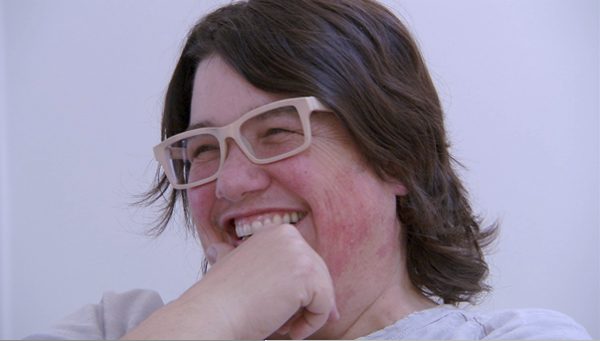America’s preeminent lesbian photographer, Catherine Opie, reflects on her identity
Art in the Twenty-First Century is a must-see series for art buffs, especially lesbian art buffs, as season six includes the preeminent out lesbian photographer Catherine Opie among its 13 profiles of artists from around the world. This program, which consists of four, one-hour episodes based on the themes of Change, Balance, History and Boundaries, opens up the lofty topic of art and makes it readily accessible to the viewer.
We see reveal artists at work and describing what they do in simple and yet often profound terms. Opie in particular is a master of using the power of art as a visual medium to challenge convention and make us see the world around us if with fresh eyes.
Over the last 25 years or so, we have seen a handful of female photographers rise to mainstream prominence: Cindy Sherman, Annie Leibovitz and Nan Goldin, to name a few. Opie may be slightly less well known, but her work is rising in prominence. She exhibited at the Guggenheim in 2009 to critical acclaim, and she and her family were the subject of a profile in The New York Times Magazine in 2010.
But she is also one of the few lesbian photographers to make an impact on the mainstream. Her series Girlfriends, which features portraits of queer female icons from k.d. lang to Jenny Shimizu to JD Samson, was landmark series capturing queer female identity. How does she feel being classified as our pre-eminent lesbian photographer? “I’m fine with it.
I made work in relation to my own community because I think that it’s really important. For me it’s very political. Now that I’m almost 51 years old I realize how the work has really influenced a much younger generation as well.
I get thanked quite often for making the images that I make so I don’t really mind being pigeonholed in relationship to that identity. It’s something that I’m proud of—that I’ve been able to make work has been poignant for a lot of people.”
Originally from Sandusky, Ohio but based in Los Angeles, Opie specializes in documentary photography, capturing people and places with images that have a candid impact. also a professor, Opie is keen to instruct others on the essential elements of the art of photography.
“I feel that it’s really important for people to understand artists and see our processes.” While today, especially with the high quality images produced by iPhones, “everybody makes a picture,” she admits. But to be a professional photographer like herself, there are things you need beyond a trigger happy thumb.
“I think that it’s really important to have a personal vision. To have an incredible sense of awareness [of] what it means to create images and how they operate. I think it’s important to have a good knowledge of art history as well as of contemporary issues…and patience and perseverance. Photography takes an enormous amount of patience. Sometimes you’re waiting for a really long time for the right light.”
Recently, Opie made her students at UCLA use only 4×10 cameras, those boxy contraptions used in early photography, for two weeks. “It was amazing to me how much more rigorous as image makers they became because they weren’t just reacting—they were having to compose, to think about light, they were having all these technical challenges.
The people who are holding up their cell phones and thinking they’re getting a great picture—yeah, it is, but at the same time there’s all this other process that goes into making solid bodies of work.”
While Opie has photographed many different subjects, from surfers to deserted urban landscapes, the themes of queer identity and female strength are central to her work. Take her portraits of marathon swimmer and friend, Diana Nyad: the camera lens almost burrows into the subject to capture Nyad’s singular strength balanced with vulnerability in a riveting portrait.
Her advice to aspiring queer photographers? “One of the things that has worked for me is that even though I’m an out lesbian, I don’t believe in a singular identity so I’ve made other bodies of work in relationship to the way that I respond to and look at the world as well.
I think that diversity in my work has made it more palatable for the mainstream than if I was ‘only’ just a queer photographer. People who really are much more set within their own subculture have a harder time moving within the art world, I think.”
She pauses for a moment to reflect, as though waiting for the right light. “I could be wrong. I hope I’m wrong,” she laughs.
Season 6 of Art in the Twenty-First Century featuring Catherine Opie premieres April 13, 2012 at 9:00 p.m. on PBS. For our full interview with Opie, see Curve’s June issue. The Art in the Twenty-First Century DVD will be on sale in May.
